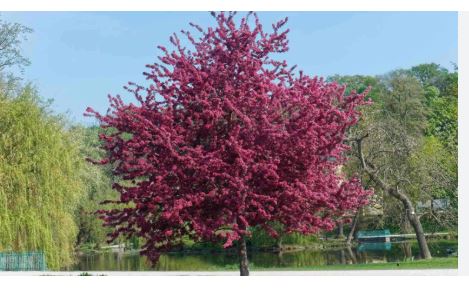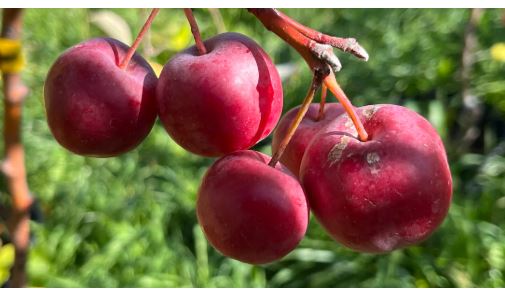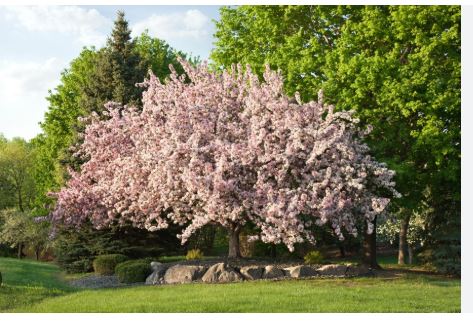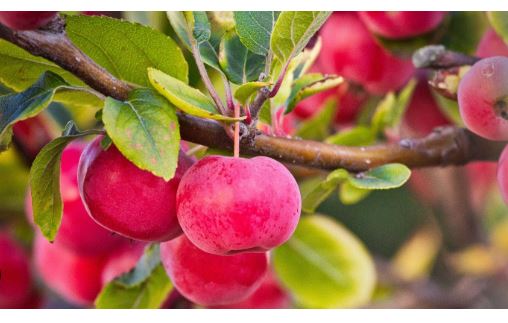
Crabapple trees belong to the genus Malus in the Rosaceae family, closely related to domesticated apples (Malus domestica). They are classified as small-fruited apple species, with fruit typically under 2 inches in diameter. Over 35 species and numerous cultivars exist, varying in size, bloom, and fruit characteristics.
Crabapples have been cultivated for centuries, with origins in Asia and Europe. Ancient Greeks and Romans used them for food and ornamentation. By the 18th century, European settlers brought crabapples to North America, where they were bred for hardiness and aesthetics, leading to modern ornamental and fruiting cultivars.
Crabapples are native to temperate regions of the Northern Hemisphere, including Asia (e.g., Malus sieversii in Central Asia), Europe, and North America. Wild species thrive in diverse climates, from forests to grasslands, with many modern cultivars bred for global adaptability.
Crabapple trees range from 6-30 feet tall, with shapes from upright to weeping. They produce vibrant spring flowers (white, pink, or red) and small apples in shades of red, yellow, or orange. Leaves are typically oval, with some cultivars showing purple or bronze foliage. Most are deciduous and hardy in USDA zones 3-8.
Crabapples are used ornamentally for their blooms, foliage, and persistent fruit in landscapes, parks, and streetscapes. Fruiting varieties are harvested for jellies, cider, and sauces. They also attract wildlife, serve as pollinators for apple orchards, and provide wood for small crafts.
Crabapple fruit is rich in antioxidants, particularly polyphenols, which may reduce inflammation and support heart health. They contain vitamin C and fiber, aiding digestion. However, their tartness often requires processing (e.g., into jellies), and seeds should be avoided due to trace cyanide content. Always consult a professional before consuming.

Flowering Crabapple Varieties

Malus ‘Adirondack’
- Description: A compact, upright tree (10-12 feet tall) with a dense, narrow form. It’s prized for its profuse white flowers and small, bright red fruit that persists into winter.
- Bloom: Pure white, late spring.
- Fruit: Small, red, edible but tart; great for wildlife.
- Features: Excellent disease resistance (scab, fire blight, cedar-apple rust). Ideal for small gardens or as a focal point.
- Zone: 4-8.
- Description: A medium-sized tree (15-20 feet) with a rounded canopy. Known for its vibrant, deep pink to red flowers and dark red fruit.
- Bloom: Bright pinkish-red, mid-spring.
- Fruit: Small, dark red, persistent; good for jellies.
- Features: High disease resistance and striking reddish-purple foliage in spring. Great for suburban landscapes.
- Zone: 4-8.
Malus ‘Royal Raindrops’
- Description: A medium-sized tree (15-20 feet) with a spreading habit and deeply lobed, purple foliage that turns orange-red in fall.
- Bloom: Bright magenta-pink, single flowers.
- Fruit: Small, bright red, persistent; attracts birds.
- Features: Excellent disease resistance and drought tolerance. Stunning foliage color makes it a year-round ornamental.
- Zone: 4-8.
Malus sargentii (Sargent Crabapple)
- Description: A dwarf, spreading shrub or small tree (6-10 feet) with a wide, low canopy.
- Bloom: Profuse, fragrant white flowers.
- Fruit: Tiny, bright red, edible; popular with birds.
- Features: Good disease resistance and ideal for small spaces or as a hedge. Multi-season interest with fall foliage.
- Zone: 4-8.
Malus ‘Sugar Tyme’
- Description: A medium-sized tree (14-18 feet) with an oval, upright shape.
- Bloom: Pale pink buds open to white, fragrant flowers.
- Fruit: Small, bright red, persistent; good for wildlife or jellies.
- Features: Excellent disease resistance and showy fruit display. Perfect for street trees or mixed borders.
- Zone: 4-8.
Malus ‘Donald Wyman’
- Description: A medium-sized tree (15-20 feet) with a rounded form and glossy green foliage.
- Bloom: White, single flowers from pink buds.
- Fruit: Bright red, small, persistent; attracts birds.
- Features: Strong disease resistance and reliable blooming. Named after a famed horticulturist, it’s a classic choice for landscapes.
- Zone: 4-8.
Malus ‘Lollipop’
- Description: A dwarf tree (8-10 feet) with a compact, rounded, lollipop-like shape.
- Bloom: White, abundant flowers.
- Fruit: Small, yellow to red, edible but tart.
- Features: Good disease resistance and perfect for small gardens, patios, or containers. Low maintenance.
- Zone: 4-8.
Malus ‘Indian Magic’
- Description: A medium-sized tree (15-20 feet) with a rounded, spreading form.
- Bloom: Deep pink to red flowers, single, in mid-spring.
- Fruit: Small, glossy red-orange apples, persistent into winter; attracts birds.
- Features: Good disease resistance, especially to scab and fire blight. Vibrant fall foliage in shades of orange and red. Ideal for suburban yards or as a specimen tree.
- Zone: 4-8.
Malus ‘Profusion’
- Description: A medium-sized tree (15-20 feet) with a broad, spreading canopy.
- Bloom: Deep pink to purple-red flowers, abundant and showy.
- Fruit: Small, dark red, persistent; good for wildlife.
- Features: Moderate disease resistance. Striking purplish new foliage fades to bronze-green. Great for adding bold color to landscapes.
- Zone: 4-8.
Malus ‘Red Jewel’
- Description: A small to medium tree (12-15 feet) with an upright, oval shape.
- Bloom: White flowers from pink buds, fragrant.
- Fruit: Small, bright red, highly persistent (often lasting through winter); excellent for visual appeal and birds.
- Features: Excellent disease resistance. Compact size suits small gardens or street planting.
- Zone: 4-8.
Malus ‘Snowdrift’
- Description: A medium-sized tree (15-20 feet) with a dense, rounded canopy.
- Bloom: White, single flowers, very profuse.
- Fruit: Small, orange-red, persistent; good for wildlife.
- Features: Good disease resistance and vigorous growth. Reliable bloomer, ideal for hedges or as a focal point.
- Zone: 4-8.
Malus ‘Louisa’
- Description: A small, weeping tree (10-12 feet) with a graceful, cascading form.
- Bloom: Soft pink to white flowers, delicate and abundant.
- Fruit: Small, yellow, persistent; attracts birds.
- Features: Excellent disease resistance. Perfect for small gardens or as an accent near patios. Weeping habit adds elegance.
- Zone: 4-8.
Malus ‘Coralburst’
- Description: A dwarf tree (8-10 feet) with a compact, rounded form.
- Bloom: Coral-pink buds open to semi-double pink flowers.
- Fruit: Small, bronze, sparse but persistent.
- Features: Good disease resistance. Ideal for tiny yards, containers, or courtyards due to its petite size.
- Zone: 4-8.
Malus ‘Radiant’
- Description: A medium-sized tree (15-20 feet) with a spreading, rounded shape.
- Bloom: Bright pinkish-red, single flowers, very showy.
- Fruit: Small, bright red, persistent; good for jellies or wildlife.
- Features: Moderate disease resistance. Vibrant spring blooms and red fruit make it a standout in mixed borders.
- Zone: 4-8.
Fruiting Crabapple Varieties

Malus ‘Dolgo’
- Description: A vigorous, upright tree (20-30 feet) with a wide spread.
- Bloom: White, fragrant flowers.
- Fruit: Bright red, 1-inch apples, tart but excellent for jellies and cider.
- Features: Good disease resistance and heavy fruit production. Popular for homesteads and culinary uses.
- Zone: 3-8.
Malus ‘Centurion’
- Description: An upright, medium-sized tree (15-25 feet) with a narrow canopy.
- Bloom: Bright pinkish-red flowers.
- Fruit: Large (for a crabapple), bright red, edible, good for preserves.
- Features: Moderate disease resistance. Striking flowers and fruit make it a dual-purpose tree.
- Zone: 4-8.
Malus ‘Chestnut’
- Description: A medium-sized tree (15-20 feet) with a rounded shape.
- Bloom: White flowers.
- Fruit: Large, reddish-bronze, sweet-tart; excellent for fresh eating or cooking.
- Features: Good disease resistance and productive fruit yields. A favorite for home orchards.
- Zone: 4-8.
Malus ‘Wickson’
- Description: A small to medium tree (10-15 feet) bred for fruit quality.
- Bloom: White to pale pink flowers.
- Fruit: Small, yellow-red, sweet, and juicy; ideal for cider and fresh eating.
- Features: Moderate disease resistance. Developed by Albert Etter, it’s a heirloom variety for fruit enthusiasts.
- Zone: 4-8.
Malus ‘Kerr’
- Description: A small tree (10-15 feet) with a compact form, often used in colder climates.
- Bloom: White flowers.
- Fruit: Dark red, medium-sized, tart; great for jellies and sauces.
- Features: Excellent cold hardiness and decent disease resistance. Popular in northern regions.
- Zone: 3-7.
Malus ‘Transcendent’
- Description: A medium-sized tree (15-20 feet) with a spreading habit.
- Bloom: White flowers.
- Fruit: Large, red-blushed yellow apples, crisp and sweet-tart; good for fresh eating or cooking.
- Features: Moderate disease resistance. A reliable producer for home gardeners.
- Zone: 4-8.
Malus ‘Hopa’
- Description: A medium-sized tree (15-25 feet) with a rounded, open form.
- Bloom: Pink to white flowers, very showy.
- Fruit: Small, red-orange, edible but tart; used for jellies or wildlife.
- Features: Moderate disease resistance but valued for its vigorous growth and colorful fruit.
- Zone: 4-8.
Malus ‘Whitney’
- Description: A medium-sized tree (12-16 feet) with a rounded form.
- Bloom: White flowers, moderately showy.
- Fruit: Large (1.5-2 inches), red-striped yellow apples, sweet-tart; excellent for fresh eating, cider, or preserves.
- Features: Good disease resistance and cold hardiness. A productive heirloom variety for home orchards.
- Zone: 3-8.
Malus ‘Evereste’
- Description: A small to medium tree (12-15 feet) with a conical, upright shape.
- Bloom: White flowers from pink buds, abundant.
- Fruit: Small, red-orange, persistent; good for jellies and wildlife.
- Features: Excellent disease resistance and long-lasting fruit display. Popular in Europe for both ornamental and culinary use.
- Zone: 4-8.
Malus ‘Hyslop’
- Description: A medium-sized tree (15-20 feet) with an upright, spreading habit.
- Bloom: White flowers, simple but attractive.
- Fruit: Large (for crabapples), dark red with a bluish bloom, tart; great for jellies and sauces.
- Features: Moderate disease resistance. A traditional variety for culinary use, especially in preserves.
- Zone: 3-7.
Malus ‘Callaway’
- Description: A medium-sized tree (15-20 feet) with a rounded canopy.
- Bloom: White, single flowers, profuse.
- Fruit: Large, bright red, sweet-tart; good for fresh eating or cooking.
- Features: Good disease resistance. Reliable fruit production and attractive blooms make it a dual-purpose tree.
- Zone: 4-8.
Malus ‘Trailman’
- Description: A small to medium tree (10-15 feet) bred for cold climates.
- Bloom: White flowers, moderately showy.
- Fruit: Medium-sized, yellow-red, sweet; excellent for cider or fresh eating.
- Features: Excellent cold hardiness and decent disease resistance. Ideal for northern orchards.
- Zone: 3-7.
Malus ‘Golden Hornet’
- Description: A small to medium tree (12-15 feet) with an upright, spreading form.
- Bloom: White flowers from pink buds, abundant.
- Fruit: Small, bright yellow, persistent; good for jellies or decorative appeal.
- Features: Good disease resistance. Striking yellow fruit adds late-season color.
- Zone: 4-8.
Malus ‘Manchurian’
- Description: A medium-sized tree (15-20 feet) with a rounded, open canopy.
- Bloom: White, fragrant flowers, early spring.
- Fruit: Small, red or yellow, tart; used for jellies or wildlife.
- Features: Excellent cold hardiness and moderate disease resistance. Often used as a pollinator for other apple varieties.
- Zone: 3-7.
General Notes on Crabapple Trees
- Size and Shape: Crabapples range from dwarf (6-10 feet) to medium (15-30 feet) trees, with shapes from upright to weeping or spreading. Choose based on your garden space.
- Fruit: Crabapples are defined as apples under 2 inches in diameter. Fruiting varieties often have larger, tastier fruit for culinary use, while flowering varieties prioritize persistent fruit for wildlife or aesthetics.
- Disease Resistance: Many modern cultivars (e.g., ‘Adirondack,’ ‘Prairifire’) are bred for resistance to common apple diseases like scab, fire blight, and cedar-apple rust. Older varieties like ‘Hopa’ may be more susceptible.
- Pollination: Most crabapples are self-pollinating but benefit from cross-pollination for better fruit set. Planting multiple varieties nearby can improve yields.
- Uses: Flowering crabapples enhance landscapes with blooms and foliage, while fruiting varieties are great for jellies, cider, or attracting birds.
- Care: Plant in full sun with well-drained soil. Prune in late winter to maintain shape and remove dead wood. Regular watering and mulching help young trees establish.
Recommendations
- For Small Gardens: ‘Sargent,’ ‘Lollipop,’ or ‘Adirondack’ for compact size and disease resistance.
- For Fruit Production: ‘Dolgo,’ ‘Chestnut,’ or ‘Wickson’ for high-quality, edible fruit.
- For Ornamental Appeal: ‘Prairifire,’ ‘Royal Raindrops,’ or ‘Sugar Tyme’ for vibrant flowers and foliage.
- Cold Climates: ‘Kerr’ or ‘Dolgo’ for superior hardiness.